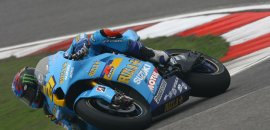Trail brakingFrom TrackpediaTrail-braking is an advanced style for braking on a track. Braking creates a forward weight transfer, which gives more Grip to the front tires, allowing to generate more adhension. A small portion of this additional amount of adhension will be used for the sake of decelerating the car, but most of it can be used to aid in steering the car more effectively. The problem is that too much braking (a common mistake) can cause several issues:
However, if you brake just lightly you will get the advantage of:
It's always recommended to brake lightly into the turn-in ("Brake turning"), but with skill, you will manage to continue braking the car through the first half of the corner, and thus delay braking on the straight even further. It's highly recommended, yet it requires skill and therefore is an advanced technique that is only adopted later on. It's not too hard to achieve, though, and we recommend to use it (once mastered the racing line) around sharp and slow corners, where it is both more beneficial and more easy. With skill, you could also use trail braking with your left foot at medium-speed corners (combined braking) with the right foot covering the accelerator. Once you finish braking, you can move to Neutral throttle, and than to progressive acceleration (just before the APEX). Neutral or balanced Throttle is when the driver only feathers or covers the throttle, applying just enough power to keep the car at a constant speed, not accelerating nor decelerating. It's best used in a rear-wheel drive. This should not be mistaken with "Trailing Throttle", which refers to lifting-off of the throttle at the corner entry (technique used in slalom courses) or mid-corner, which is not recommended. Throttle maintanence means keeping the power down through the corner, and "Breathing the throttle" means steering the car with the amount of power rather than the steering lock. If you trailbrake and end-up oversteering, you can straighten the wheel while locking up the wheels. Than, ease off of the brakes to a pressure slightly lower than before and countersteer as nessecary. This should get the car through the corner without reducing your braking effort significantly. Often, once you initiate the sequence of trail braking and are about to reach the APEX, it often requires lifting off of the brakes and dabbing the accelerator slightly to accelerate momentarily to avoid oversteer, lift-off again before the APEX and regain acceleration sense as you APEX. Some racing schools maintain the mantra of finishing all your braking in a straight line, but lately, a great portion of the greater and more prestigious racing schools are begining to adopt brake-turning and trail-braking into their guidance. We strongly recommend this. |
